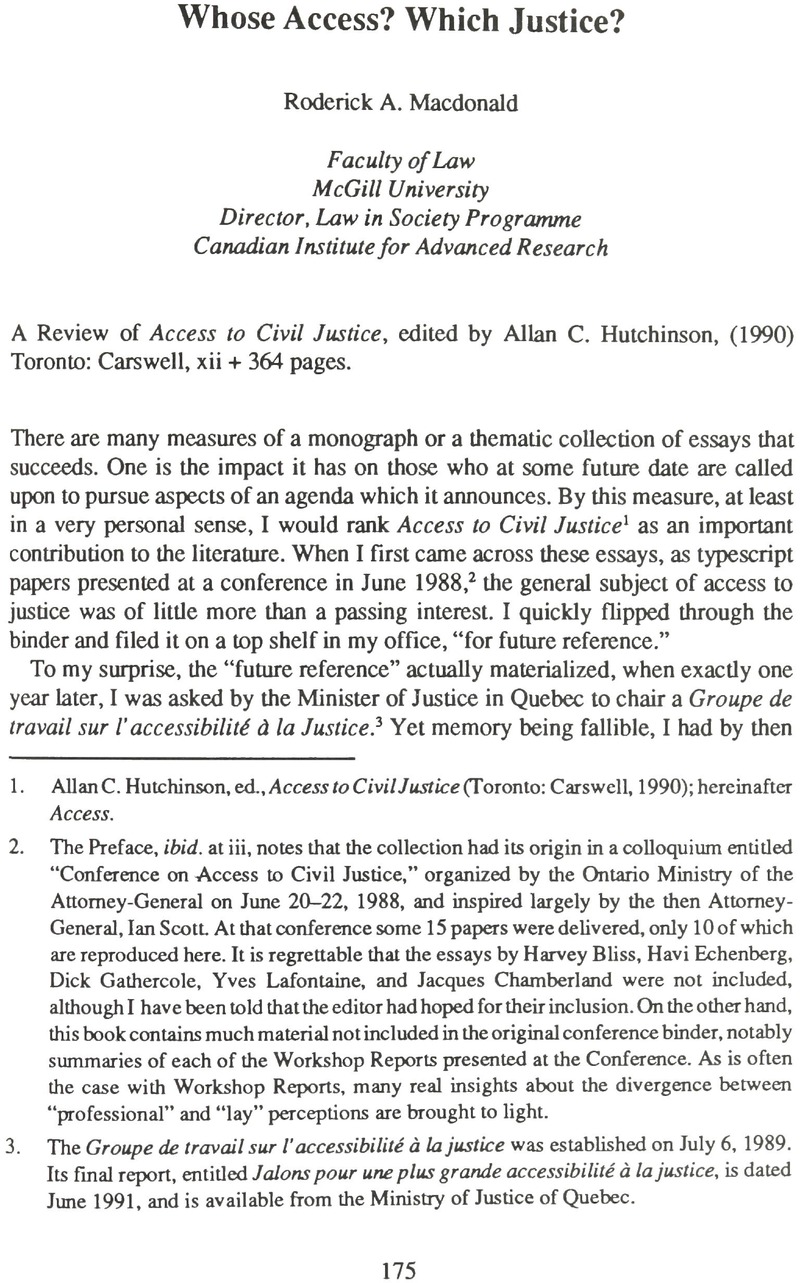No CrossRef data available.
Article contents
Whose Access? Which Justice?
Published online by Cambridge University Press: 18 July 2014
Abstract

- Type
- Notes critiques/Review Essays
- Information
- Canadian Journal of Law and Society / La Revue Canadienne Droit et Société , Volume 7 , Issue 1 , Printemps/spring 1992 , pp. 175 - 184
- Copyright
- Copyright © Canadian Law and Society Association 1992
References
1. Hutchinson, Allan C., ed., Access to Civil Justice (Toronto: Carswell, 1990)Google Scholar; hereinafter Access.
2. The Preface, ibid. at iii, notes that the collection had its origin in a colloquium entitled “Conference on Access to Civil Justice,” organized by the Ontario Ministry of the Attorney-General on June 20–22, 1988, and inspired largely by the then Attorney-General, Ian Scott At that conference some 15 papers were delivered, only 10 of which are reproduced here. It is regrettable that the essays by Harvey Bliss, Havi Echenberg, Dick Gathercole, Yves Lafontaine, and Jacques Chamberland were not included, although I have been told that the editor had hoped for their inclusion. On the other hand, this book contains much material not included in the original conference binder, notably summaries of each of the Workshop Reports presented at the Conference. As is often the case with Workshop Reports, many real insights about the divergence between “professional” and “lay” perceptions are brought to light.
3. The Groupe de travail sur l'accessibilité à la justice was established on July 6, 1989. Its final report, entitled Jalons pour une plus grande accessibilité à la justice, is dated June 1991, and is available from the Ministry of Justice of Quebec.
4. Whether the conference papers actually shaped our deliberations or whether we independently worked out a similar agenda I really cannot say. Once rediscovered, however, the papers were to play an important role in informing those early deliberations of the Groupe de travail leading up to its First Report, submitted in May 1990. Of course, as the concluding paragraphs of this review reveal, in our Final Report we departed somewhat from the vision implicit in this collection. Indeed, we proposed several measures which emerged from a critical evaluation of the themes raised in several of the essays, and a considered rejection of many proposals made therein.
5. Editor's Introduction in Access at vii–xii. The bulk of this introduction is devoted to situating the essays in the context of the Conference's various plenary sessions, although the first two and final paragraphs clearly reveal the editor's own views.
6. “Problems and Experience With the Ontario Civil Justice System: An Empirical Assessment” in Access at 1–51Google Scholar.
7. “Access to Civil Justice: A Review of Canadian Legal Academic Scholarship: 1977–1987” in Access at 53–76Google Scholar. In the table of contents, the essay is listed as being that of Professor Mossman alone, although on its title page it is identified as being by Professor Mossman with Heather Ritchie. Following citation convention, I have adopted the latter style of attribution.
8. “L'accessibilité à la justice civile et administrative au Québec” in Access at 77–105Google Scholar.
9. “Critical Moments in Access to Justice Theory: The Quest for the Empowered Self” in Access at 107–28Google Scholar.
10. “Seeking Justice in a Corporate Society” in Access at 129–53Google Scholar.
11. “Competing Objectives in Civil Justice: The German Experience” in Access at 155–76Google Scholar.
12. “Barriers to Access: Including the Excluded” in Access at 177–201Google Scholar.
13. “Access to Civil Justice For Aboriginal Peoples” in Access at 203–35Google Scholar.
14. “Making the System Balance: Beyond the Zuber Report” in Access at 237–56Google Scholar.
15. “Varieties of Mediation Performance: Replicating Differences in Access to Justice” in Access at 257–75Google Scholar.
16. These Workshops were entitled: the Minority Voice, Gender, Literacy and Legal Language, Native and Remote Justice, Public Legal Education, Physical and Mental Disabilities, Language and Rights, Intervenor Status and Funding, Zuber and Beyond, Poverty Lawyering, Lawyer's Fees, Paralegals, Legal Aid, Contingency Fees, Middle Class Difficulties, Community Clinics, Access to Appointments, Neighbourhood and Lay Justice, Privatization, Mediation, Arbitration, Native Courts, Administrative Tribunals, and Group Claims/Collective Rights. See Access at 277–353.
17. The Sommet de la Justice, subtitled “La justice: une responsabilité à partager,” was an initiative of the Quebec Ministry of Justice intended to celebrate its 25th year of existence. A major theme of the Sommet, held between February 17 and February 20, 1992, was access to justice.
18. I also have a number of other small criticisms of the collection which it is useful to mention here. It would have been nice to have had a list of the non-reproduced conference papers and their authors. An introduction and conclusion to the Workshop Reports would have given the reader a better sense of their overall tenor. A general bibliography of all the theoretical and empirical sources cited, or at the very least a bibliographic essay, would have made the collection a more useful reference tool. A two or three page critique of each essay, either commissioned separately or written by the editor himself would have situated the various essays within an ongoing dialogue. I raise these suggestions not because the collection is deficient without them, but because I believe that the book will become a standard reference work in the field. And if such is a probability, it would have been even more valuable with these additions.
19. For a further development of the ideas in this and the next paragraph see Macdonald, R. A., “Access to Justice and Law Reform” (1991) 10 Wind. Y.B. Acc. Just. 1Google Scholar.
20. Walzer, Michael, Spheres of Justice (New York: Basic Books, 1983)Google Scholar.




